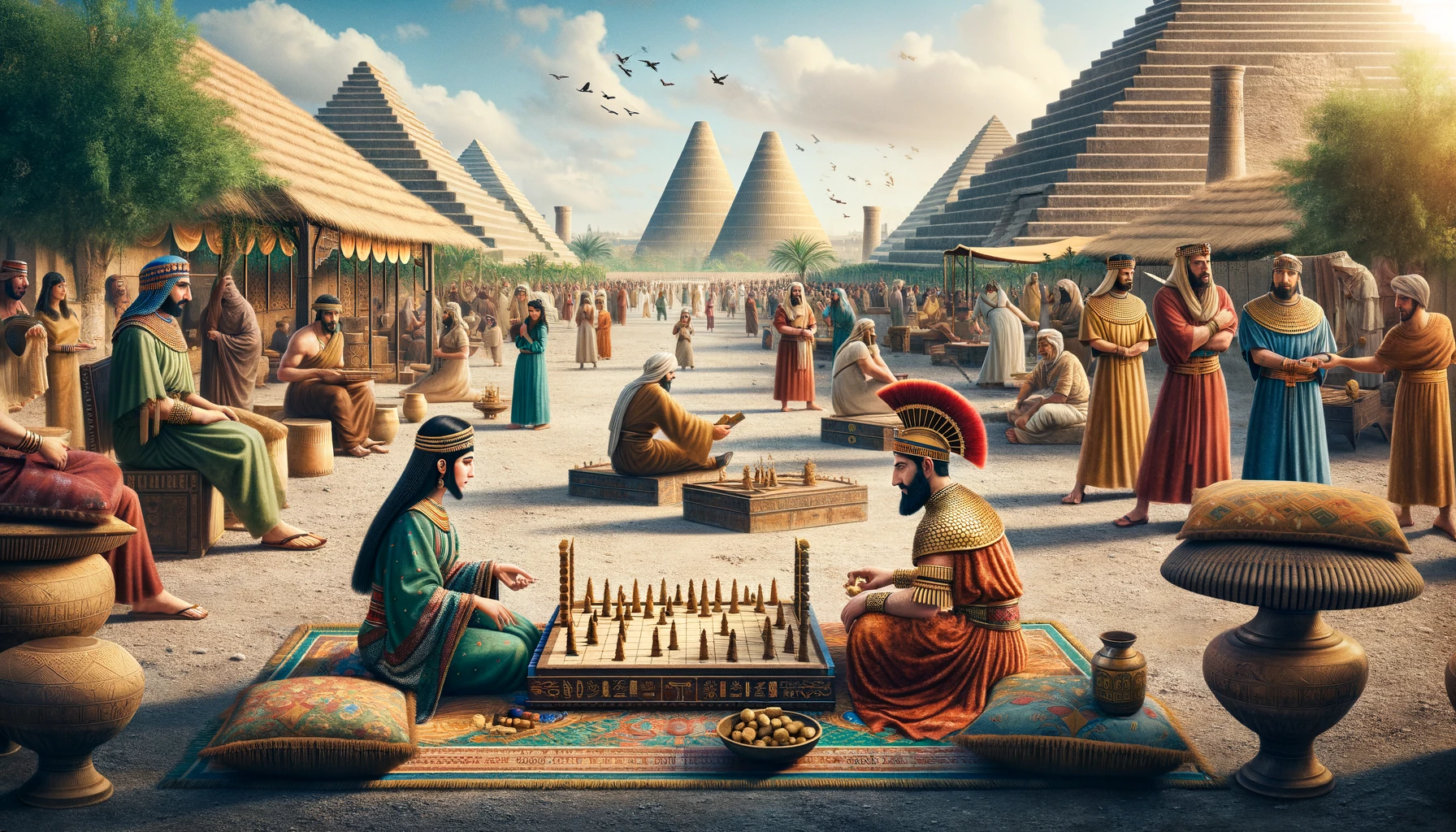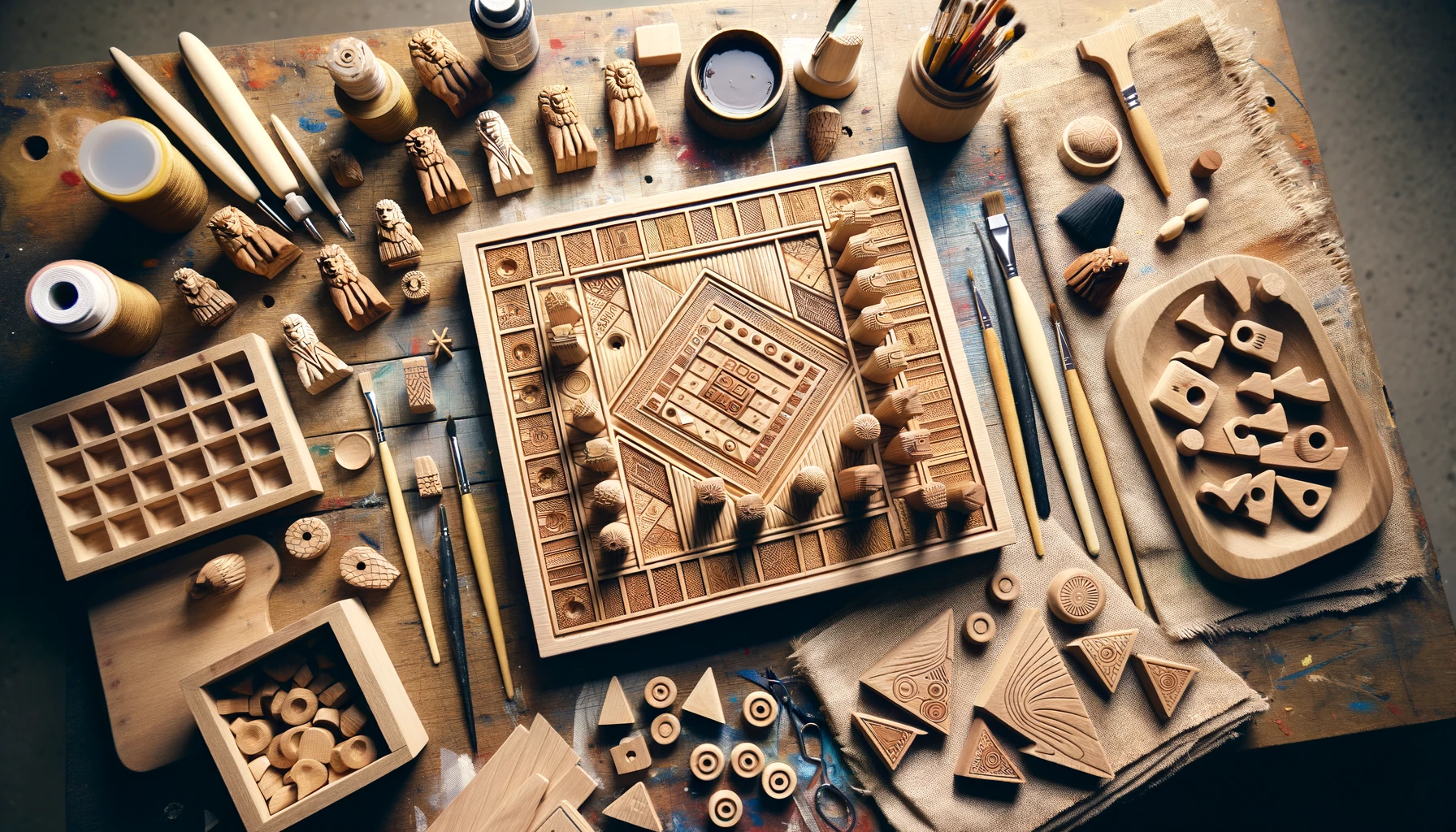Exploring the Ancient Game of Ur: A Journey into the World’s Oldest Board Game
Historical Background of the Royal Game of Ur
The Royal Game of Ur, also known as the ‘Game of Twenty Squares’, holds a revered place in the annals of ancient gaming history. Its origins trace back to the early third millennium BCE, nestled in the heart of Mesopotamia, one of the cradles of civilization.
Discovered in the 1920s during Sir Leonard Woolley’s famous excavations at the Royal Tombs of Ur, this game offers a tantalizing glimpse into the leisurely pursuits of our ancestors. The find comprised several game boards, with the most exquisite one presumed to have belonged to a high-status individual, possibly royalty.

The game’s longevity and widespread appeal are evidenced by its presence across various ancient cultures, from Mesopotamia to Persia, and even reaching the shores of the Mediterranean. Intriguingly, versions of this game were found in diverse locations, underscoring its popularity and adaptability across different societies.
The craftsmanship of the Ur game boards, with their intricate inlays of shell, red limestone, and lapis lazuli, speaks volumes about the importance of this game in ancient times. It was not merely a pastime but a symbol of status and sophistication.
The Game Mechanics of the Royal Game of Ur
The Royal Game of Ur, with its distinctive twenty-square patterned board, is not just an artifact but a testament to the strategic and intellectual pursuits of ancient civilizations. Its gameplay, though rooted in antiquity, has parallels to modern board games, reflecting a blend of strategy and chance.
The Board and Its Layout: The board consists of a 3×8 grid of squares, with an intriguing arrangement that suggests a path of movement for the game pieces. The most notable feature is the rosette squares, believed to offer players a safe spot or a bonus turn.
The Game Pieces and Dice: Players each have seven pieces, which they move according to the rolls of four-sided dice or binary lots, such as knucklebones or specially marked sticks. The goal is to navigate the pieces across the board and safely off, while strategically blocking or capturing opponent’s pieces.
Gameplay Strategy: The Royal Game of Ur combines elements of luck and strategy. Decisions on which piece to move, whether to play aggressively or defensively, and how to best use the rosette squares are crucial. This makes the game both simple to learn and rich in tactical depth.
Reconstructed Rules: The exact rules of the game were a mystery until the discovery of a cuneiform tablet by Irving Finkel, a curator at the British Museum. This tablet, dating back to 177 BC, provided a detailed description of the gameplay, allowing modern enthusiasts to revive the ancient game accurately.
The enduring appeal of the Royal Game of Ur lies in its balanced combination of strategy and chance, making it a captivating pastime even today. This section offers readers an understanding of the game’s mechanics, setting the stage for exploring its cultural significance and modern-day revival in the following sections.
Attached is a close-up image of the game pieces and board, showcasing the intricate design and craftsmanship of this ancient game.
Cultural Significance of the Royal Game of Ur
The Royal Game of Ur was more than just a source of entertainment; it was a reflection of the social and religious fabric of ancient Mesopotamian society.
Symbol of Status and Intellectual Prowess: Possession of a Game of Ur set, especially ones made with luxurious materials, was a symbol of high social status and intellectual refinement. The game was often found in burial sites, indicating its importance as a cherished possession for the afterlife.
Religious and Mythological Connections: The game’s design and gameplay were likely intertwined with Mesopotamian religious beliefs and mythology. The rosette symbols on the board, for instance, might have had religious significance, possibly representing aspects of fertility, luck, or protection.
Social Interaction and Education: The game also served as a tool for social interaction, bringing together people from different walks of life. It is believed that, through gameplay, individuals could learn about strategy, mathematics, and the unpredictability of fate, reflecting the values and education of the time.
Reflection of Ancient Life and Cosmology: The game’s popularity across various regions suggests that it was a part of the cultural exchange and interaction among ancient civilizations. Its design and evolution offer insights into the artistic styles, material culture, and cosmological views of these societies.
In essence, the Royal Game of Ur was an integral part of Mesopotamian culture, offering insights into the society’s social structure, religious beliefs, and everyday interactions. This section highlights the game’s role beyond mere entertainment, emphasizing its significance in the broader context of ancient Mesopotamian life.
The Game’s Legacy and Revival
The Royal Game of Ur, transcending millennia, continues to captivate and intrigue modern audiences, showcasing a remarkable journey from ancient artifact to contemporary pastime.
Enduring Legacy: The game’s enduring presence highlights its timeless appeal. Its discovery and subsequent studies have sparked a renewed interest in ancient board games, leading to a broader understanding of historical pastimes and their impact on modern gaming culture.
Scholarly Interest and Reconstruction: Scholars like Irving Finkel played a pivotal role in resurrecting the game for modern players. The deciphering of cuneiform texts and meticulous reconstruction of the rules have allowed people today to experience the game as it was played thousands of years ago.
Modern Adaptations and Online Versions: In today’s digital age, the Game of Ur has found new life through online platforms and mobile apps. These versions maintain the essence of the original game while making it accessible to a global audience.
Educational Value and Cultural Appreciation: The revival of the Royal Game of Ur serves not only as entertainment but also as an educational tool. It provides insights into ancient civilizations, helping to foster a deeper appreciation for historical cultures and their contributions to society.
Community and Competitive Play: The game has also developed a community of enthusiasts who organize tournaments and share strategies. This contemporary interest in an ancient game underscores the universal appeal of board games and their ability to connect people across time and cultures.
Playing the Game Today
The Royal Game of Ur’s revival brings an ancient pastime into the hands of contemporary enthusiasts, offering a unique blend of historical appreciation and entertainment.
Creating Your Own Game Set: For those interested in a hands-on experience, crafting a DIY Game of Ur set can be both educational and enjoyable. Instructions and templates are available online, allowing players to recreate the intricate board and pieces using modern materials.

Learning the Rules: The reconstructed rules, based on ancient texts, are now readily accessible. Websites, historical gaming forums, and instructional videos provide clear guidelines on how to play, making it easy for beginners to dive into the game.
You can find the rules for the Royal Game of Ur on several websites. The game is an ancient race board game for two players, where the goal is to advance all your pieces around and off the board before your opponent. The rules involve rolling unique tetrahedral dice, moving pieces according to the roll, capturing opponent pieces, and utilizing special rosette tiles for strategic advantage.
One detailed resource for the rules is on RoyalUr.net, which provides a comprehensive guide including the basics of gameplay, different rule variations proposed by scholars. They have also included alternative rule sets for more variety in gameplay. This website is a great place to start for both beginners and experienced players looking to explore different ways to play the game.
Online Platforms and Apps: Technology has made the Game of Ur more accessible than ever. Several online platforms and mobile apps offer digital versions of the game, allowing players to compete against others around the world or against AI opponents.
Educational Use in Schools: The game has also found a place in educational settings. Teachers use it to engage students in ancient history and cultural studies, offering a hands-on learning experience that brings ancient civilizations to life.
Community Engagement and Tournaments: The growing community of Game of Ur players often organizes tournaments and meetups, both in-person and online. This fosters a sense of community among players, encouraging both competitive play and cultural exchange.
FAQ’s
What is the Royal Game of Ur?
The Royal Game of Ur is an ancient board game originating from Mesopotamia, played over 4,500 years ago.
How is the Royal Game of Ur played?
Players roll dice to move their pieces across the board, with the objective to navigate all pieces off the board first while capturing opponents’ pieces.
What do the rosette squares in the game signify?
Rosette squares offer strategic advantages, providing players with extra dice rolls and serving as safe spots for pieces.
Can the Royal Game of Ur be played online?
Yes, there are digital versions of the game available online, allowing players to play against AI or other players.
Is the Royal Game of Ur still popular today?
The game has seen a revival in recent years, with enthusiasts enjoying both physical and digital versions worldwide.
What are the pieces in the Royal Game of Ur made of?
Historically, the pieces were made of various materials like wood, stone, or bone, often decorated with intricate designs.
Are there different rule sets for the Royal Game of Ur?
Yes, there are several reconstructed rule sets, the most notable being the Finkel rules, based on ancient texts.
Is the Royal Game of Ur suitable for children?
The game is both educational and entertaining, making it suitable for older children interested in history and strategy games.
How long does a game of Ur typically last?
A typical game of Ur can last anywhere from 10 to 20 minutes, depending on the players’ strategies and the roll of the dice.



